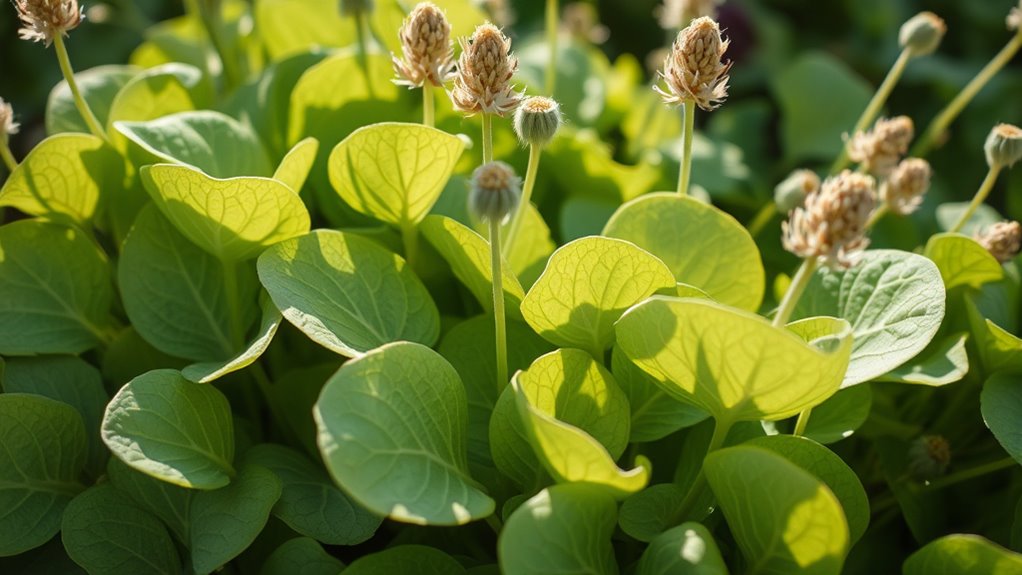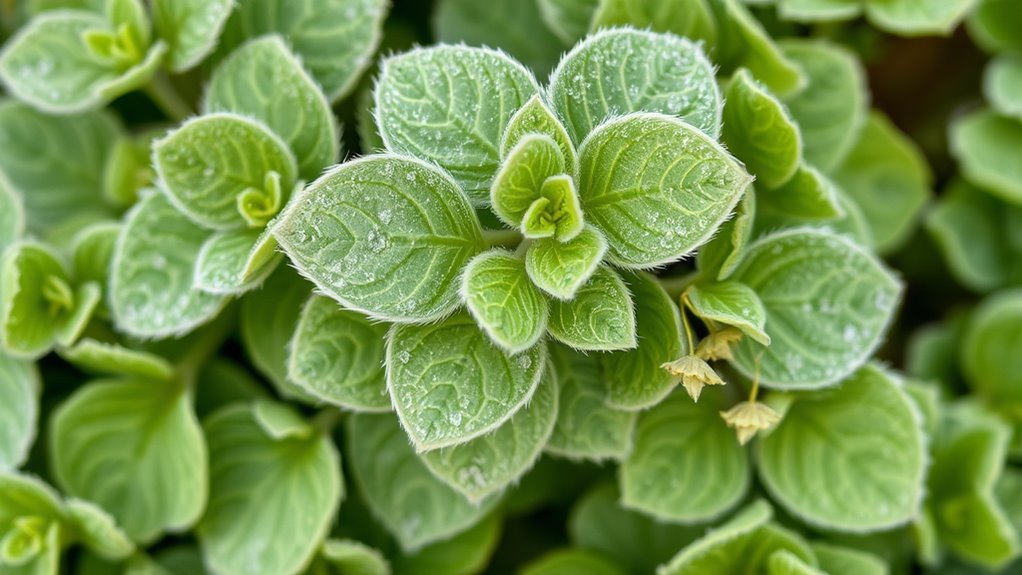Lamb’s Quarters offers abundant late-season seeds that you can harvest and roast or grind into flour for baking and porridge, extending its usefulness beyond leaves. The leaves are rich in vitamins and minerals, and cooking them reduces oxalates, making them easier to digest and more nutritious. Focus on mature seed stalks and leaves for the best harvest, ensuring you identify the plant correctly to avoid look-alikes. Keep exploring for more tips on how to maximize this wild superfood.
Key Takeaways
- Harvest mature leaves before flowering for maximum nutrition and flavor, and cook to reduce oxalates.
- Collect seeds from dense clusters atop plants, then roast or grind them into flour for baking or porridge.
- Use late-season leaves in sautéed dishes, smoothies, or soups to access their nutrient density.
- Seed harvesting extends the plant’s utility, providing a wildcrafted, nutritious ingredient year-round.
- Confirm plant identity to avoid toxic look-alikes and ensure safe, sustainable foraging practices.

Have you ever come across Lamb’s Quarters and wondered if it’s just another common weed or something more useful? If you’re seeking liberation from the confines of conventional food sources, this resilient plant offers a treasure trove of possibilities. It’s time to see Lamb’s Quarters not as a nuisance but as a powerful ally in your journey toward self-sufficiency. Foraging tips can help you identify and harvest this plant safely, emphasizing the importance of mature leaves and young seed stalks. In the wild, Lamb’s Quarters flourish in disturbed soils, so look for their distinctive, diamond-shaped leaves with a slightly powdery coating. When foraging, always confirm plant identification with multiple sources to avoid confusion with toxic look-alikes. Once identified, harvest the tender leaves before flowering for the best flavor and nutritional punch. Color accuracy impacts the visual appeal of the greens, making proper identification and harvest even more rewarding.
Discover Lamb’s Quarters: a resilient, nutritious wild green to enhance your self-sufficiency journey.
Lamb’s Quarters packs a remarkable nutritional benefits profile. It’s rich in vitamins A, C, and K, along with minerals like calcium, magnesium, and iron. These nutrients support your immune system, improve skin health, and boost energy levels. Unlike some cultivated greens, Lamb’s Quarters can grow abundantly, making it an accessible, free food source that empowers you to take control of your diet. Its high protein content and dense nutrient profile make it a true superfood, especially valuable during late-season foraging when fresh greens become scarce. Incorporating Lamb’s Quarters into your meals allows you to enjoy a wild, wildcrafted flavor that’s both earthy and satisfying.
When it’s time to harvest the seeds, you’ll notice they form in dense clusters atop the mature plant. These seeds are another edible resource, often overlooked. Roasted or ground into flour, they can serve as a nutritious addition to baked goods or porridge. The leaves, however, are the star for late-season use, offering fresh greens even when other vegetables have dwindled. Cooking the leaves reduces oxalates, making them easier to digest and more nutritious. Sauté them with garlic and olive oil, blend into smoothies, or add them to soups—your options are plentiful once you’ve embraced this plant’s versatility.
Liberating yourself from reliance on store-bought greens begins with understanding and utilizing plants like Lamb’s Quarters. With proper foraging tips and an awareness of its nutritional benefits, you tap into a sustainable, wild resource that’s been waiting for you. You’re not just harvesting a weed—you’re reclaiming your food sovereignty and connecting more deeply with nature’s abundant gifts.
Frequently Asked Questions
How Can I Identify Lamb’s Quarters in the Wild?
To identify lamb’s quarters in the wild, look for a tall, leafy plant with diamond-shaped, toothed leaves that are often covered in a fine white powder, giving them a silvery appearance. Its edible plant traits include tender leaves and seed clusters that are easy to spot. As you explore wildflower identification, remember this plant’s distinctive look and enjoy the liberation of foraging for nourishing, wild food sources.
Are There Any Health Risks Associated With Eating Lamb’s Quarters?
You’ll be glad to know lamb’s quarters is generally safe to eat, but watch out for toxicity concerns and allergy risks. About 2% of people may experience allergic reactions, so try a small amount first. No serious toxicity issues are common, yet consuming large quantities can cause digestive discomfort. Stay informed, listen to your body, and enjoy this wild edible’s nutrition without worry, embracing your freedom to forage safely.
What Are the Best Preservation Methods for Late-Season Seeds?
You should prioritize seed storage by thoroughly drying lamb’s quarters seeds using effective drying techniques like air drying in a cool, dark place. Make certain the seeds are completely dry to prevent mold and preserve their viability. Once dried, store them in airtight containers, such as glass jars or sealed bags, in a cool, dark location. This method keeps your seeds fresh, ready for future planting, giving you the freedom to harvest and enjoy your garden at your own pace.
Can Lamb’s Quarters Be Cultivated Intentionally?
Yes, you can cultivate lamb’s quarters intentionally, turning your garden into a wild, green sanctuary. Embrace cultivation techniques like soil preparation and strategic planting, guiding these resilient weeds to flourish on your terms. Harvest seeds with care, like gathering treasures from a hidden forest, and watch as your plot becomes a liberating haven of nutrient-rich greens. Take control and let nature’s wild spirit grow on your own terms.
How Do the Nutritional Benefits of Lamb’s Quarters Compare to Other Greens?
You’ll find lamb’s quarters pack a stronger nutritional punch compared to many other greens. Its high levels of vitamins A, C, and K, along with minerals like calcium, iron, and magnesium, boost your dietary benefits markedly. Unlike some greens, it’s easy to forage and enjoy freely, giving you the power to take control of your nutrition and embrace a more liberated, self-sufficient lifestyle. Lamb’s quarters truly empower your health choices.
Conclusion
As you harvest Lamb’s Quarters, remember it’s more than just a plant—it’s a symbol of resilience and abundance. Its seeds and leaves remind you that even in late seasons, life offers nourishment and hope. Embrace this resilient gift, knowing that just like Lamb’s Quarters, you too can thrive when you adapt and persevere. Let it inspire you to find sustenance and strength in every ending, trusting new beginnings are always nearby.










